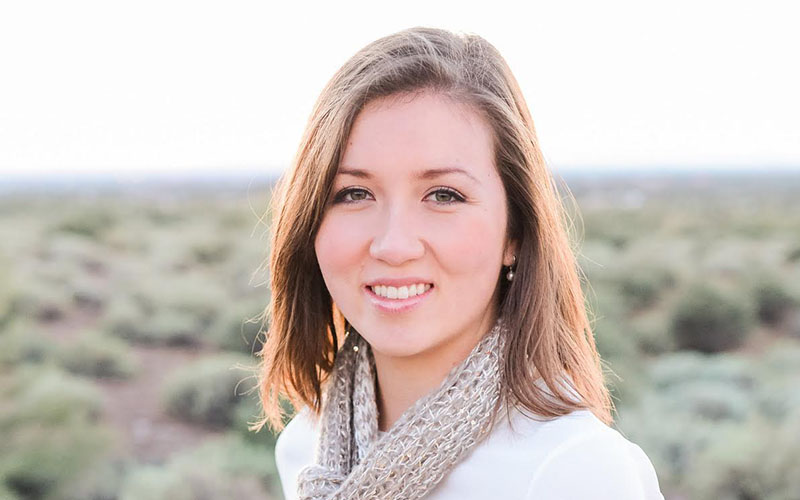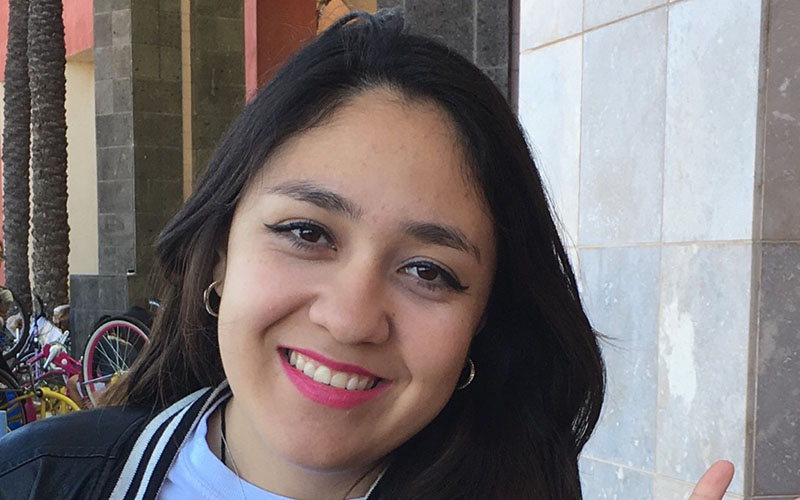
Christen Webb, speech and hearing sciences major, attended Mesa Community College before transfering to Arizona State University, and graduating in 2017. She plans to start graduate school in the fall. (Photo courtesy of Christen Webb)
PHOENIX – Arizona universities are working to drive up Arizona college graduation rates, smoothing the way for students transferring from community college, offering financial aid and adding online classes to draw non-traditional students.
Less than one out of three students in Arizona in 2013 earned a four-year degree in six years or less, according to a 2015 report by the U.S. Department of Education.
The Arizona Board of Regents, which oversees the state’s three public universities, said in a 2015 statement their combined graduation rates were 59.8 percent in 2015-16, nearly five percent higher than the national average.
The regents’ goal is to increase graduation rates to 65.6 percent by 2020.
Student success relies on financial help
Gabriela Rodriguez, a sophomore majoring in criminal justice, knew she wanted to stay close to her family in Nogales, Arizona. When Arizona State University offered her top scholarships, it was an offer she couldn’t refuse.
“Growing up, I wanted to go to Yale. As I got older, I decided I had to stay in state because of family,” Rodriguez said.
The difficult transition from high school to college is a leading factor in why students drop out, but Rodriguez says her move to Arizona State was relatively smooth, despite first semester struggles.
“Learning to live in a dorm was very different. I also had to learn to manage my time,” Rodriguez said.
Other students, such as Jason Schiffman, a public relations major who graduated from ASU this year, decided to start at a community college because of its smaller class sizes and affordable tuition. It also gave him time to discover what career he wanted to pursue.
“It eased me into things. I learned how to be a college student a little bit better,” Schiffman said.
Schiffman recommends that students who are unsure of their goals start at a two-year institution.
“I didn’t know what I wanted to do, so I went to Mesa Community College to save money there while I figured things out,” Schiffman said.
Schiffman received the Presidents’ Honors Scholarship, aid provided to high school graduates for four semesters to attend a school in the Maricopa Community College District.
“The two years I spent at MCC I spent a total of $35 on tuition,” Schiffman said.
Christen Webb, a speech and hearing sciences major who graduated this year, also attended Mesa Community College on a scholarship.
“It seemed like I had my whole college career half-off,” Webb said. “I’ve known a lot of people that there isn’t financial support or it is impossible for them to work full time, go to school, and live on their own.”
Rodriguez said the problem stems from universities being too expensive for students. The average tuition per year for in-state residents at ASU alone is near $9,500.

Gabriella Rodriguez is a sophomore criminal justice major at Arizona State University. She hopes to graduate in 2020 and possibly get a job with the Drug Enforcement Agency. (Photo courtesy of Gabriela Rodriguez)
University programs prepare transfer students
Rose Rojas, who oversees the curriculum and transfer student program at Maricopa Community College District, said she knows what it’s like to be a transfer student. She attended Phoenix College.
“I was hesitant to tell people I was going to community college because I went to a college prep (in high school) but I am glad I did,” Rojas said.
Rojas initially enrolled as a nursing major, switched to psychology, and now loves her job in education.
When Rojas transferred to ASU, the transition programs that are in place now didn’t exist, and some of her coursework didn’t carry over to the university.
“I think that is how I developed my passion,” Rojas said. “Now I can help students utilize these programs.”
The community college district develops “pathway” programs to make it easier for students to transfer to 50 four-year universities across the U.S.
The programs map specific courses students need to complete at community colleges to successfully transfer to four-year colleges as juniors.
“If a student didn’t have a pathway, the student could be taking classes and be disappointed when they find out it doesn’t correlate with their programs,” Rojas said. The district’s partnerships with other universities also allows student to complete their bachelor degrees at community colleges.
The Arizona Board of Regents is asking the state’s public universities to increase the number of bachelor’s degrees presented to community college transfer students, according to public documents provided by the regents.
Transfer students were awarded more than 7,500 bachelor’s degrees in 2015-16 academic year, just short of the 7,770 goal the regents set, the documents show.
The board estimates community college transfer students will earn nearly 7,850 bachelor’s degrees for the 2016-17 academic year and about 9,550 undergraduate transfer students will get their degrees in 2025.
Online programs continue to grow
In 2010, Arizona State University joined a national movement to create online courses, drawing non-traditional students such as mid-career workers and out-of-state students who rarely set foot on a campus.
Seven years later, ASU Online has nearly 26,000 students enrolled, nearly a quarter of the university’s enrollment, according to Joe Chapman, director of student services at ASU Online.
“Our demographic age group is higher,” Chapman said, adding that most of their students have a full-time job and children.
“They tried finishing their degree before but it didn’t work out for whatever reason, and now they are giving it a second go,” Chapman said.
ASU Online also provides financial assistance to Starbucks employees.
Starbucks reimburses costs for employees who complete their undergraduate degrees online. Chapman said about 6,000 of the school’s students are taking advantage of this program.
ASU Online programs are available to students around the world, with Arizona residents making up 30 to 40 percent of those enrolled, Chapman said.
“While AZ as a whole might be struggling, we are doing everything that we can to focus on each student,” Chapman said of the state’s low graduation rates.
The Arizona Board of Regents doesn’t have a set goal for online student graduation, but state that online university programs promote flexibility and other pathways to higher education.
ASU President Michael Crow wants to have 100,000 online students by 2025, Chapman said.
“We certainly have our work cut out for us,” said Chapman. “A lot of students need degrees but don’t have the ability to attend on campus, and so it is really about giving people the opportunity that otherwise wouldn’t have had that.”
The University of Arizona and Northern Arizona University also have online degree programs that allow students to get a college education off campus.

Jason Schiffman, a public relations major, graduated from Arizona State University in 2017. He is searching for employment in both the non-profit or sports industries. (Photo courtesy of Jason Schiffman)
Troubling graduation rates
Rose Rojas, with the Maricopa Community College District, says there are many reasons why a student may not complete their degrees.
“What you are seeing in the grade schools, carries to high school, carries into college,” Rojas said.
Dual-enrollment students also count against the district’s dropout rates, which vary by institution, she said.
“We have dual enrollment students who were never interested in community college, they just took courses in high school,” Rojas said.
Rojas says some students come to a community college to take few general education classes or perhaps a foreign language, then transfer to a university without completing their associate’s degree.
Public university graduation
The state’s three public universities – ASU, the University of Arizona in Tucson and Northern Arizona University in Flagstaff – awarded more than 27,400 bachelor’s degrees in 2015-16, surpassing the board’s goal of 27,281, according to data the Board of Regents has collected.
In the 2016-17 school year, the board hoped to present more than 28,500 bachelor’s degrees. By spring 2025, the goal is to award more than 40,000 students with undergraduate degrees.